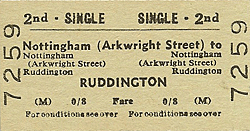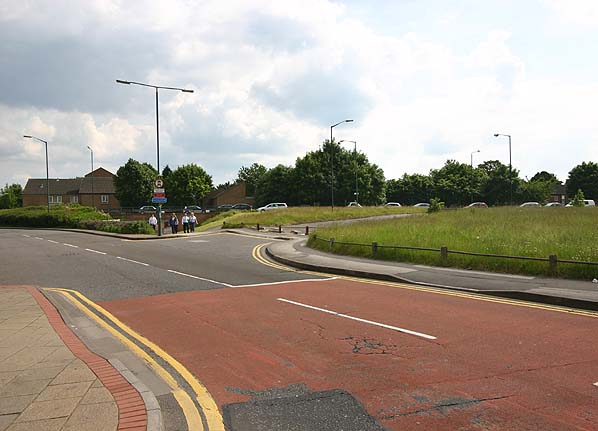
Station Name: NOTTINGHAM ARKWRIGHT STREET
|
| Date opened: | 15.3.1899 |
| Location: | South of the junction of Arkwright Street and Crocus Street |
| Company on opening: | Great Central Railway |
| Date closed to passengers: | 5.5.1969 |
| Date closed completely: | 5.5.1969 |
| Company on closing: | British Railways (London Midland Region) |
| Present state: | Demolished - no evidence of the station remains |
| County: | Nottinghamshire |
| OS Grid Ref: | SK574390 |
| Date of visit: | 1.6.2008 |
Notes: Arkwright Street was one of the few stations on the London Extension that didn't have an island platform. It had two side platforms built onto the viaduct spanning Arkwright Street. The entrance and booking office was at street level in Crocus Street where two brick towers housed the stairs up to the platforms. The platform buildings were constructed largely of timber with the main building on the down side platform (towards Nottingham) and a waiting shelter on the up side. The station never had goods facilities. A loco shed was opened with the line south of Arkwright Street station on the east side of the line. It was a 4 track straight dead-ended shed with a northlight pattern roof. Facilities included a ramped coaling stage a water tower and a turntable. Although recorded as closed in 1907 it continued in use as storage and servicing at least until 1953.
BRIEF HISTORY OF THE GREAT CENTRAL RAILWAY BETWEEN SHEFFIELD AND LONDON In 1854, Edward Watkin became General Manager and then in 1864 chairman of the Company. Watkin's ambition was to build a rail link between the industrial heartland of Manchester and Sheffield, south to London and through a tunnel beneath the channel to reach Paris and the expanding markets of Continental Europe. In order to fulfil his ambitions, Watkin also became Chairman of the Metropolitan Railway who were in the process of extending their line northwards towards Rickmansworth and the South Eastern Railway connecting London with Dover. Initially, Watkin tried to convince other companies to build links with the MS & L allowing him to reach London but he was unable to reach agreement and eventually was left with little option than to build his own line southward from Sheffield to reach the Metropolitan.
In 1893 the MS&LR obtained Parliamentary approval to extend this line to London (known as the ‘London Extension’. Construction of the 92 mile route started in 1895 and on 1st August 1897 the company changed its name to the Great Central Railway; it was the last 'main line' to be built until the Channel Tunnel rail link in 2003. Due to its late construction, the company was able to take advantage of the latest technology including steam excavators. It was heavily engineered with viaducts and wide cuttings with a maximum gradient of 1 in 128; there were no sharp curves or level crossings which would ensure a fast service for both passengers and freight. Most of the stations on the ‘London extension’ were built to a standard design consisting of an island platform with the booking office located on the platform. All the stations were built on an embankment or in a cutting adjacent to a road bridge, with access via stairs from the middle of the bridge; only the larger intermediate stations like Rugby and Loughborough had street level buildings. Because Edward Watkin also expected his trains to reach Europe through a channel tunnel, the line was also built to a larger continental (Berne) loading gauge. The Great Central opened for coal traffic on 25 July 1898, for passenger traffic to a new terminus at Marylebone on 15 March 1899 and for general goods traffic on 11 April 1899. The new line was built from Annesley in Nottinghamshire to join the existing Metropolitan Railway which had now reached Quainton Road in Buckinghamshire, where the line became joint Met/GCR owned (after 1903), it returned to GCR metals near Finchley Road for the final section into Marylebone. In 1903, new rails were laid parallel to the Metropolitan Railway from Harrow to the junction north of Finchley Road, enabling more traffic to use Marylebone. Although the new line had now reached London, Edward Watkin was unable to fulfil his ambition as he was forced to retire through ill health.
From the outset, the line had to compete with established north – south routes and the first train only carried a disappointing four passengers so the company had to work hard to win passengers from its rivals; with a well managed Advertising campaign and the introduction of a fast and efficient train service the companies fortunes slowly improved although it was never a match for its rival lines. In the 1923 grouping, the Great Central became part of the London & North Eastern Railway which brought an increase in freight traffic from the south Midlands and south west England but the LNER's main north - south route was into London Kings Cross so the Great Central was always considered as a secondary route.
to London express services were withdrawn on 2nd January 1960 leaving only three semi-fast trains a day and it came as little surprise when the line became the first main line to close in the Beeching era. Beeching considered that the Great Central was a duplicate route which could be sacrificed in favour of the Midland main line. The NTHC's aim was to reinstate the remaining line into Loughborough where it joins the GCR
North of Aylesbury the track remains in place but is only used by waste freight trains to the landfill site at Calvert where a junction with the Oxford - Cambridge line remains in use. On selected days, usually bank holidays, special passenger services run to the Buckinghamshire Railway Centre at Quainton Road station. There are now proposals to extend the passenger services northwards to a new station called Aylesbury Vale Parkway at the point where the line crosses the A41 near Berryfields Farm. This area is to be known as the Berryfields Major Development Area and will include park and ride facilities for Aylesbury. With our motorway network now working at capacity there have been a number of proposals to reopen other sections of the Great Central main line and in 2006 Central Railway was formed to look into the feasibility of building a new rail link from central England to the Channel Tunnel which would include rebuilding part of the Great Central route south of Rugby reviving a 1990’s government proposal to reopen that section of the line as part of a fast rail link from Scotland to the Channel Tunnel. Preservation group web sites: The Buckinghamshire Railway Centre, The Great Central Railway (steam service between Loughborough and Leicester North) & Nottingham Transport Heritage Centre (steam service between Ruddington and Loughborough) Selected other web sites: The Transport Archive contains further detailed history of the Great Central plus a vast collection of 2344 'on line' photographs many ( the Newton Collection) taken during the construction of the London Extension. Chris Ward's Annesley Web site featuring numerous photographs of the Great Central around Nottingham and the Annesley Motive Power Depot. Great Central Railway through Leicester. Nigel Tout's web site with numerous photographs of the Great Central remains around Leicester and a series of archive photographs of the line. Bridging the Gap details ongoing work to reinstate the link between the two preserved lines. The Great Central Railway Society promotes an historical interest in the Great Central Railway. Selected further reading: Great Central Memories by John MC Healey published 1987 by Baton Transport ISBN 0 85936 193 4 - heavily illustrated history of the London Extension. Great Central Then and Now by Mac Hawkins - published (2nd edition) by BCA 1992 ISBN 0 7153 9326 X , station by station photographic survey of the Great Central between Sheffield and London with numerous 'then and now' photographs. See also Sheepbridge & Brimington Station and construction of the Manchester, Sheffield and Lincolnshire Railway through Brimington by Philip Cousins. Published in St. Michael & All Saints, Brimington parish magazine. (Click here for full text). All tickets from Michael Stewart. Too see other stations on the Great Central Railway between Sheffield Victoria and Aylesbury click on the station name: Aylesbury, Waddesdon, Quainton Road (1st site), Quainton Road (2nd site)**, Calvert, Finmere, Brackley Central, Helmdon, Culworth, Woodford Halse, Charwelton, Braunston & Willoughby, Rugby Central, Lutterworth, Ashby Magna, Whetstone, Leicester Central, Leicester North***, Belgrave & Birstall, Rothley**, Swithland****, Quorn & Woodhouse**, Loughborough Central**, East Leake, Rushcliffe Halt**, Ruddington, Ruddington Factory Halt, Nottingham Victoria, Carrington, New Basford, Bulwell Common, Bulwell Hall Halt, Hucknall Central, Annesley South Junction Halt, Hollinwell & Annesley, Kirkby Bentinck, Tibshelf Town, Pilsley, Heath, Staveley Central, Renishaw Central, Killamarsh Central, Beighton (1st site), Beighton (2nd site), Woodhouse Junction, Woodhouse*, Darnall*, Sheffield Victoria & Sheffield Bridgehouses. |
old7.jpg)
Arkwright Street Station looking north in 1960

old3.jpg)
Arkwright Street Station looking south in 1968
Photo by Ian Baker
old1.jpg)
Photo by J E Connor
4.jpg)
Photo by Nigel Tout from his Great Central Railway through Leicester web site






old_thumb5.jpg)
old_thumb16.jpg)
old_thumb6.jpg)
old_thumb4.jpg)
old_thumb2.jpg)
old_thumb13.jpg)
old_thumb14.jpg)
old_thumb15.jpg)
old_thumb7.jpg)
old_thumb8.jpg)
old_thumb10.jpg)
old_thumb11.jpg)
old_thumb9.jpg)
old_thumb12.jpg)
thumb2.jpg)
thumb3.jpg)

 Home Page
Home Page